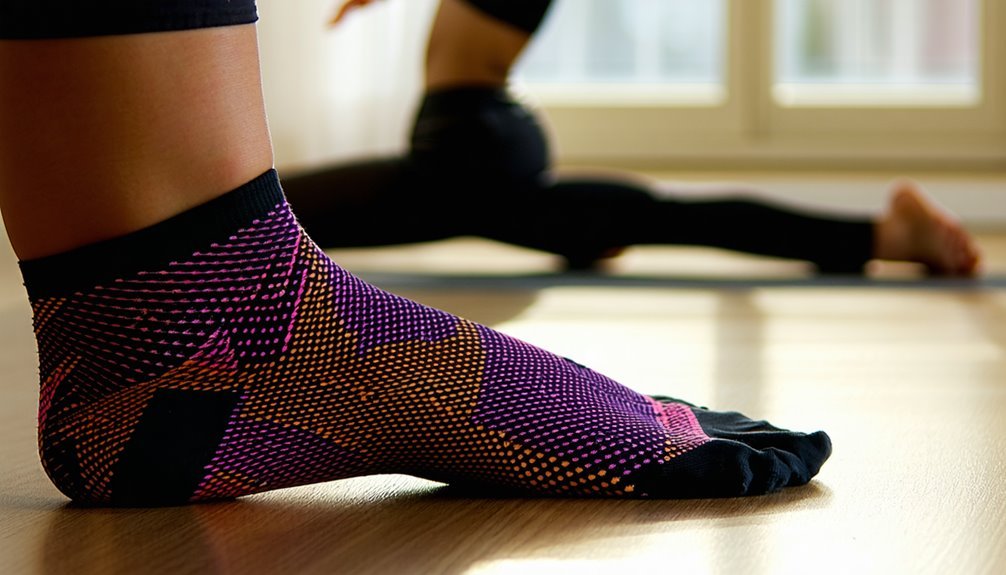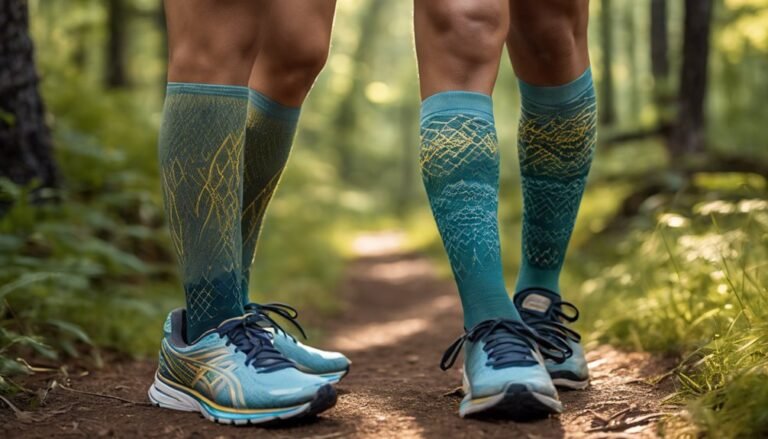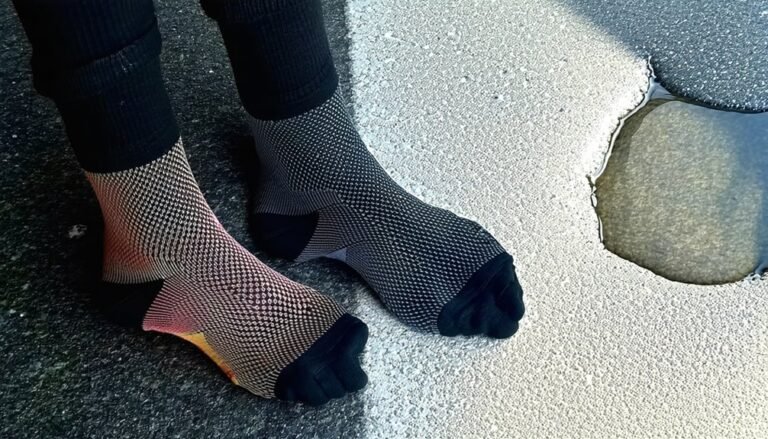Are Compression Socks Good for You
Yes, compression socks can be good for you! They enhance circulation and reduce swelling, making them great for athletes and those with circulation issues. With graduated pressure that's tighter at the ankle and looser up the leg, these socks support blood flow back to the heart. However, it's important to consult a healthcare professional before use, especially if you have underlying health conditions. Discover more about their benefits and how to choose the right ones for your needs!
Understanding Compression Socks
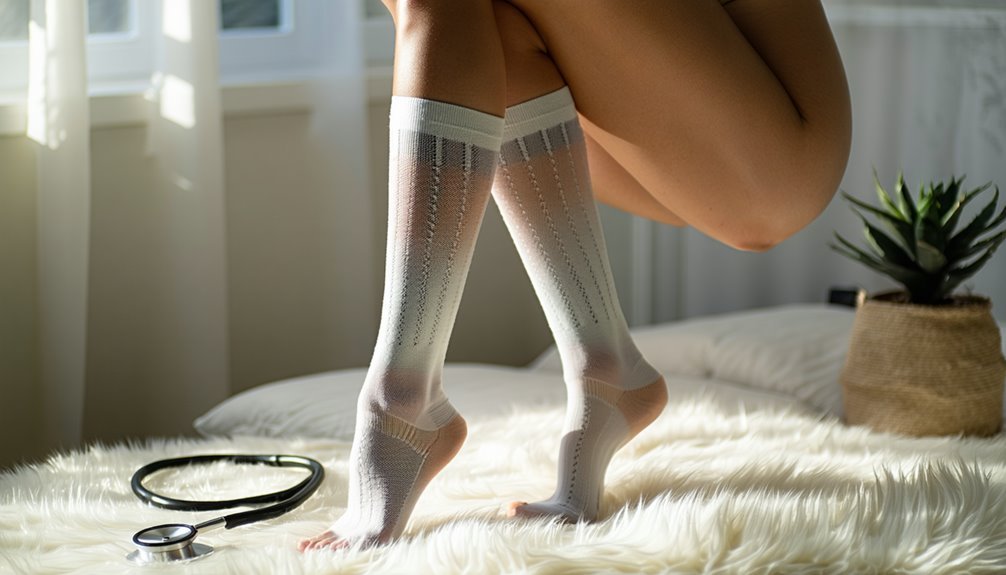
When you think about improving circulation and reducing swelling, compression socks often come to mind. These specialized garments come in various compression sock types, such as knee-high, thigh-high, and full-length options, catering to different needs and preferences. Understanding the right type for you is essential for safety and effectiveness.
Compression sock materials also play a significant role in their performance. Most socks are made from a blend of nylon, spandex, and cotton, providing a comfortable fit while ensuring adequate compression. Selecting the appropriate type and material can help you maximize benefits like enhanced circulation and minimized swelling. Always consult with a healthcare professional before starting to wear compression socks, especially if you have existing health concerns.
How Compression Socks Work
Compression socks work by applying gentle pressure to your legs, which helps enhance blood flow. This increased circulation can reduce swelling and improve muscle support during physical activities. Understanding how these socks function can help you make the most of their benefits.
Blood Flow Enhancement
Although you may not realize it, the way compression socks are designed plays a crucial role in enhancing blood flow in your legs. These socks apply graduated pressure, which means they're tighter at the ankle and gradually loosen up the leg. This design encourages better blood circulation and improves venous return, helping your body efficiently transport blood back to the heart. By promoting this enhanced flow, compression socks can reduce swelling and discomfort, making them beneficial for those who spend long hours on their feet or experience poor circulation. When worn correctly, they support your vascular system, ensuring your legs feel more energized and less fatigued. Ultimately, they help maintain healthy blood flow, which is essential for your overall well-being.
Muscle Support Mechanism
Enhanced blood flow isn't the only benefit of wearing compression socks; they also provide significant muscle support during physical activities. By applying graduated pressure, these socks help stabilize your muscles, reducing vibrations and fatigue. This support can enhance muscle recovery, allowing you to bounce back quicker after workouts. When your muscles experience less strain, you're less likely to sustain injuries, making compression socks an excellent choice for injury prevention. Whether you're running, cycling, or engaging in other sports, the right level of compression can lead to improved performance and comfort. So, if you're serious about your training, consider incorporating compression socks into your routine for that extra layer of support you need.
Benefits of Wearing Compression Socks
When you're on your feet for long periods, wearing compression socks can provide significant benefits. These specially designed socks improve circulation, helping to reduce swelling and fatigue in your legs. Available in various compression sock styles, you can choose the level of support that suits your needs best. Whether you prefer knee-high, thigh-high, or ankle-length options, there's something for everyone. Additionally, compression sock materials like nylon, spandex, and cotton offer both comfort and durability. By selecting the right combination of style and material, you can enjoy all-day support while ensuring your legs feel refreshed. Wearing compression socks not only promotes better blood flow but also may help prevent more serious issues like varicose veins and blood clots.
Who Can Benefit From Compression Socks?
Compression socks can be a game-changer for athletes and active individuals looking to enhance performance and recovery. They're also beneficial for those with circulation issues, helping to improve blood flow and reduce swelling. If you fit into either of these categories, you might find that compression socks offer significant support.
Athletes and Active Individuals
For athletes and active individuals, the right gear can make a significant difference in performance and recovery. Compression socks offer numerous benefits that can enhance your training and overall experience. Here are three key advantages:
- Performance Enhancement: By improving blood flow, compression socks help deliver more oxygen to your muscles, allowing you to perform at your best.
- Reduced Muscle Vibration: These socks stabilize your muscles during activity, which can decrease fatigue and enhance endurance.
- Shorter Recovery Time: After workouts, wearing compression socks can help reduce swelling and soreness, allowing you to bounce back quicker for your next session.
Incorporating compression socks into your routine can be a smart choice for optimizing your athletic performance and speeding up recovery.
Individuals With Circulation Issues
If you're dealing with circulation issues, you might find that compression socks can provide significant relief. These socks work as a form of circulation therapy, applying gentle pressure to your legs. This helps improve blood flow and supports venous health, reducing discomfort and swelling.
If you suffer from conditions like varicose veins or chronic venous insufficiency, compression socks can be especially beneficial. They promote better blood circulation, which can alleviate symptoms like heaviness and fatigue.
Always consult your healthcare provider before starting any new treatment, especially if you have underlying health concerns. By incorporating compression socks into your routine, you may notice improved comfort and enhanced overall well-being, making daily activities much easier to manage.
Potential Risks and Considerations
While compression socks can offer numerous benefits, it's important to weigh potential risks before using them. Being aware of compression sock risks and contraindications can help guarantee your safety. Here are three considerations to keep in mind:
- Circulatory Issues: If you have certain circulatory conditions, wearing compression socks might worsen your situation.
- Skin Reactions: Some people may experience irritation or allergic reactions to the material, so monitor your skin closely.
- Incorrect Fit: Wearing socks that are too tight can lead to discomfort or restricted blood flow, negating their benefits.
Always consult with a healthcare professional before starting compression therapy, especially if you have existing health issues. Safety should always come first!
Choosing the Right Compression Level
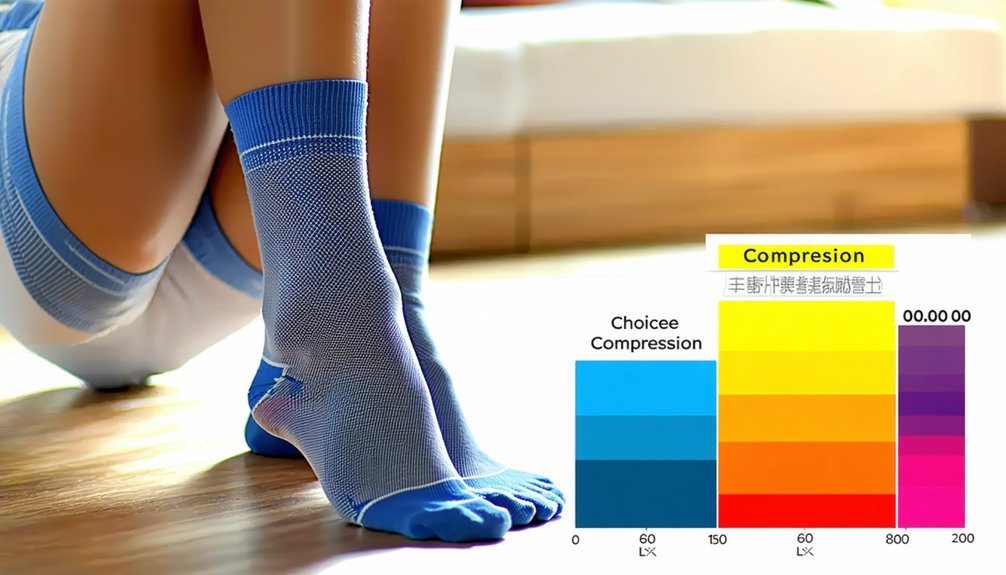
Choosing the right compression level can be crucial for maximizing the benefits of compression socks. Compression levels typically range from mild to extra firm, and selecting the appropriate one depends on your needs. If you're looking for relief from minor swelling or fatigue, a mild level (8-15 mmHg) might be suitable. For more significant issues like varicose veins or post-surgery recovery, consider moderate (15-20 mmHg) or firm levels (20-30 mmHg). It's important to consult a healthcare professional to verify you're choosing styles that match your specific condition. Remember, improper compression can lead to discomfort or complications. Always prioritize safety by understanding your body's needs before making a decision on compression levels.
How to Properly Wear Compression Socks
To guarantee you get the most out of your compression socks, it's essential to wear them correctly. Here are some wearing tips to make certain a proper fit:
- Choose the Right Size: Measure your legs to find the best fit. Compression socks should feel snug but not painfully tight.
- Put Them On Properly: Start at your toes and work your way up. Avoid rolling or folding the socks, as this can create pressure points.
- Wear Them at the Right Time: For maximum benefit, wear your compression socks during activities or when you're sitting for extended periods.
When to Consult a Healthcare Professional
When should you consider consulting a healthcare professional about your compression socks? If you experience persistent pain, swelling, or skin changes, it's crucial to seek a symptom evaluation. Additionally, if you notice any discomfort or unusual sensations while wearing your socks, don't hesitate to reach out. A healthcare provider can help determine suitable treatment options tailored to your needs.
| Symptom | Action Required | Possible Conditions |
|---|---|---|
| Persistent pain | Consult a healthcare professional | Deep vein thrombosis |
| Swelling not improving | Seek medical advice | Lymphedema |
| Skin irritation or changes | Get evaluated | Allergic reactions |
| Unusual sensations | Discuss with a doctor | Nerve issues |
Prioritizing your health is key!
Frequently Asked Questions
Can Compression Socks Be Used During Pregnancy?
Yes, you can use compression socks during pregnancy. They provide pregnancy benefits by improving circulation, reducing swelling, and minimizing discomfort. Always consult your healthcare provider to guarantee they're safe and suitable for your specific needs.
Do Compression Socks Come in Different Styles and Colors?
Yes, compression socks come in various styles and color variations, allowing you to choose fashionable options that suit your taste. Look for designs that provide both comfort and safety, enhancing your overall experience while wearing them.
How Long Do Compression Socks Last Before Needing Replacement?
Think of compression socks as a trusty pair of shoes. You'll need to replace them after about six months, or when you notice signs of wear and reduced compression—those are your replacement indicators for ideal support.
Are There Any Specific Brands Recommended for Compression Socks?
When choosing compression socks, popular brands like Sigvaris, Jobst, and CEP often come highly recommended. Look for socks made from breathable materials like nylon and spandex to guarantee comfort and effective compression for your needs.
Can Compression Socks Be Washed in a Washing Machine?
When it comes to caring for your compression socks, following washing guidelines is essential. While machine washing's possible, gentle cycles and cold water are best. Always check maintenance tips to guarantee longevity and effectiveness.

